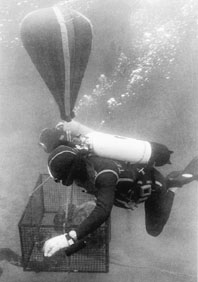

 | Page 913 |  |
Perfection of a self-contained underwater breathing apparatus (scuba) by Jacques-Yves Cousteau and Emile Gagnan in france in the 1940s revolutionized the study of ancient and historic shipwrecks by providing divers with the mobility they needed for the careful excavation of delicate ships’ hulls. A number of pioneering efforts conducted in the 1950s along the coasts of France and Italy introduced the regular use of airlifts (suction pipes) for removing overburden, air-filled lifting balloons for raising heavy objects to the surface, underwater photography, and even underwater television. In 1958, to aid in photographic mapping, Gianni Roghi, working with Nino Lamboglia, laid a tape grid over a Roman wreck at Spargi, a small island north of Sardinia; the tape was replaced in 1959 by rigid pipes.
Mistakes were unavoidably made along the way. Because careful archaeological plans were not kept, the site at Grand Congloué near Marseilles in France was thought to be that of a single Roman wreck whereas it is now recognized that it is instead one Roman wreck lying atop another of earlier date. Philippe Taillez, after his exemplary excavation of a Roman wreck near Le Titan in the same region, bemoaned the fact that diving archaeologists were not part of such excavations. Nevertheless, the nondiving archaeologists, especially Lamboglia in Italy and Fernand Benoit in France, who received finds and assessed information from the professional and amateur divers under their direction, began to pay close attention to the construction techniques of ancient ships. It became accepted that Roman ships were generally edge-joined with mortise-and-tenon joints and that hulls frequently were sheathed in lead.
Salvage mistakes were also made in North America. In 1956, the historian Edwin C. Bearss and colleagues, using a simple magnetic compass to detect a mass of iron, located the American Civil War ironclad Cairo in the Yazoo River, Mississippi, where it had lain in perfect condition since becoming, in 1862, the first vessel ever sunk by an electrically detonated mine. Beautifully preserved artifacts and what is left of the hull, which was mostly destroyed by misguided salvage methods in 1965 and a lack of prompt conservation, are displayed in the Vicksburg National Military Park.
Other wrecks, like those in the York River, were found by dragging. The Swedish engineer Anders Franzén, knowing that the Baltic Sea does not support ship worms, dragged the bottom of Stockholm’s harbor from 1953 until 1956 in a successful search for what he rightly guessed would be a perfectly preserved warship, the Vasa, which sank on its maiden voyage in 1627.
After 1960, the field of nautical archaeology expanded rapidly in a number of new directions. “Whitewater archaeology” began in Minnesota and canada when amateur divers found goods lost by fur traders who had unsuccessfully tried to shoot rapids in their canoes. These finds led to a long-term survey for other such goods by Robert C. Wheeler of the Minnesota Historical Society and Walter A. Kenyon of the Royal Ontario Museum.

Archaeologists explore an ancient shipwreck in the Mediterranean, June 1969.
(Hulton Getty)
 |  |